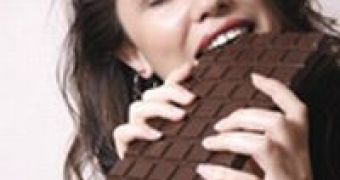The cacao tree (Theobroma cacao) is believed to have originated in South America, in the basins of Amazon or Orinoco. In 1502, Columbus was the first European to encounter the tree during his fourth voyage, but he completely ignored the fruits resembling a melon.
Two decades later, Hernan Cortes observed with amazement how the Aztec emperor Moctezuma enjoyed a cup of xocolatl (both "chocolate" and "cacao" are Aztec words). The liquid was so precious, that it was served only in gold cups, thrown away after a sole use. The Spaniard took some cacao beans which he brought to the Spanish king Carol Quintus.
Aztecs used cacao beans as coins, and the value of a slave was of 100 beans. Cocoa was considered the nectar of the Aztec gods.
Soon, "money" plantations spread to Trinidad, Haiti and western Africa. At the Spanish court, water and sugar were added to the infusion of cacao beans, and this beverage turned into the favorite of the Spanish nobles. The drink spread and, by 1770, chocolate plants competed the coffee plants.
The Swiss Daniel Peter made the first milk chocolate in 1785.
In 1828, the Dutch chemist Conrad Van Houten discovered the cocoa powder, obtained by separating the cocoa butter of the ground beans. Solid chocolate appeared in 1847, when the English company J.S.Fry and Sons (now merged with Canterbury) combined ground cacao beans with a supplement of cocoa butter and sugar. Chocolate turned even more familiar with the milk-chocolate bars, first made in 1894 in US. Cocoa butter is still used in cosmetics (creams, tanning lotions, soaps).
How is cocoa processed? After being dried, cleaned and roasted, the cacao beans are introduced in special grinding machines. Fresh beans are light colored, but they turn brown when exposed to heat. Due to the heat and friction, a thick and dark past, called chocolate liqueur, results. This is the raw material for both chocolate and cocoa powder.
The liqueur is pressed in special machines till resulting an amber colored liquid called cacao butter. What is left is pressed further until turning into cocoa powder.
If cocoa butter is added to it, the result is the dark chocolate. If only the butter is used, without the liqueur, the product is white chocolate. Some chocolates replace the cocoa butter with plant oils. One pound (0.44 kg) of chocolate require about two handfuls of cacao beans.
In some Mediterranean areas, a carob-made product resembles cocoa's flavor.
A recent research has found traces of chocolate processing, dated 3,000 years ago, in Honduras. The chocolate was an "accidental" discovery, as Central American Indians were initially using the pulp of the pods produced by the tree to make beer, discarding the seeds. Indians made chocolate of fermented cacao seeds, but around 1100 B.C., ancient Indians made only cacao beer. Later, people started using the discarded fermented seeds to make a non-alcoholic bitter beverage. The drink was poured from special pitchers that created froth in the drinking cups and served to celebrate special occasions such as marriages and births, as it was traditional in the case of Mexican Mixtecs.

 14 DAY TRIAL //
14 DAY TRIAL //